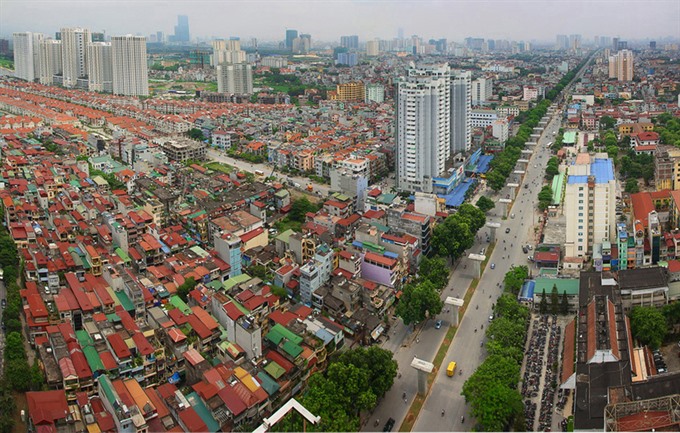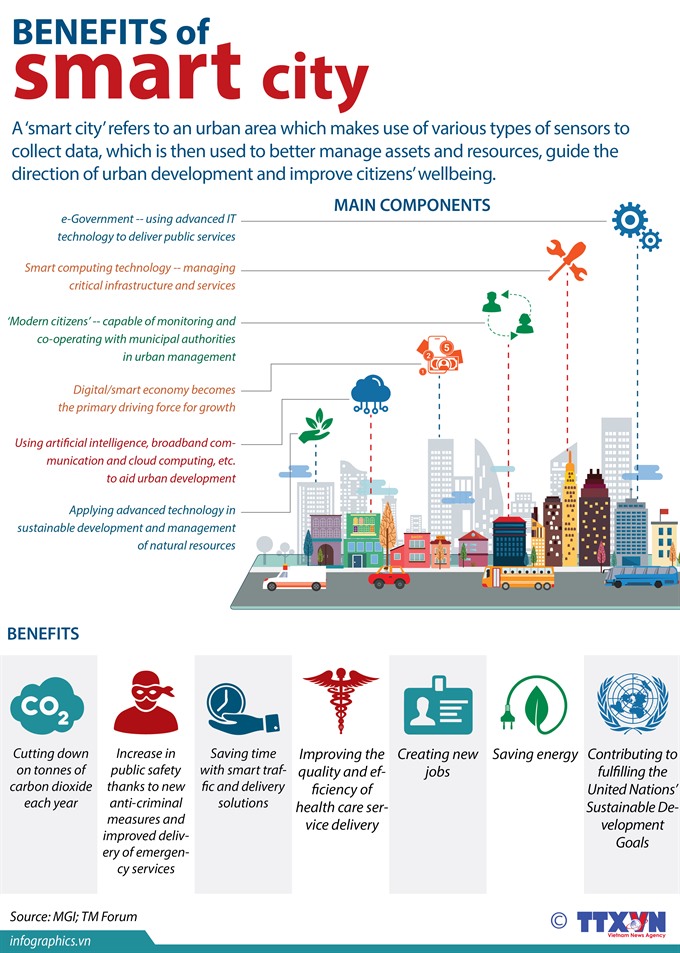 |
| A view of Ha Dong District in the southwest of Ha Noi. — VNA/VNS Photo Trong Dat |
Viet Nam News
HA NOI — Ranking among the world’s largest capitals and with a population of around 7.6 million, Ha Noi seems to be almost bursting at the seams with unceasing traffic and chaotic hubbub.
The 1000-year-old capital of Viet Nam is a lot of things — its cultural quirks, historical richness and economic vitality might be fascinating; but most wouldn’t consider it an ‘organised’ city, in the sense of modern urban centres that have come to characterise much of the developed, post-industrial economies.
At least, not yet.
Authorities in Ha Noi are attempting to rectify this ungainly mess with an ambitious ‘smart city’ project that envisages a glowing megacity where information and communication technologies are leveraged to solve existing and emerging urban challenges that face a city set to cross the 10-million-population metropolis milestone by 2030, joining the likes of Shanghai, Tokyo or New York.
Tantamount to a global sweepstake, Ha Noi, with at least 20 other municipalities across the country, has also been lured by so-called smart prospects, consistent with ‘Industrial Revolution 4.0’. The advent of said revolution enjoys an invested conviction from the highest political levels that it would be a bridge to narrow the development gap between Viet Nam and other countries in a modern, flat world.
Smart transformation of economic centres such as Ha Noi holds national importance as the city contributes 19-20 per cent of the country’s gross domestic product (GDP), and not to mention the country’s serious rural flight issue and neck-breaking urbanisation.
The capital’s initial smart endeavours, namely the deepening of ICT integration in the municipal administration’s works, reached a whopping VND3 trillion (US$128.8 million) just for the 2016-20 period alone with the city leaders arguing that this amount is just trivial figure compared to the benefits it brings.
The city has also made an international commitment by joining the ASEAN Smart Cities Network, a freshly launched key initiative championed by Singapore that is scheduled to be adopted by ASEAN leaders at the bloc’s summit later in the year.
According to Pham Thanh Long, a researcher on local governance and smart cities at University College Cork, Ireland, the network would provide a platform for transferring knowledge, common standards and best practices adopted to suit each city.
Viet Nam and Thailand reportedly have rallied behind the agenda and are willing to further promote the agenda in their chairmanship years.
The roadmap of turning Ha Noi into a “green, culturally-rich, civil and modern city with sustainable development” is divided into three phases.
The first one will be dedicated to establish “foundational components” of a smart city until 2020, followed by the five-year phase, 2021-25, where the smart components of the city will be completed, which would be the basis for the formation of digital economy, along with citizens’ engagement.
The final phase of the project, from 2015 onwards, Ha Noi will be a “highly smart city" driven by knowledge economy.
Currently, the city is focusing on building infrastructure and enhancing human resources, while prioritising traffic issues, tourism growth, healthcare, the environment and energy.
Nguyen Duc Chung, chairman of Ha Noi’s People’s Committee and Ha Noi’s Chief Smart City Officer, told Vietnam News Agency that a municipal e-Government system was taking shape.
Ha Noi has set up an online residency database for all of its 7.5 million citizens, while all departments and 30 districts and townships have already been connected to the wide-area network. An online medical database for all Hanoians is also being built, which will eventually be integrated with a nationwide network of pharmacies launched last month to stop unauthorised sales of prescription drugs and the sale of low-quality medicines.
Schools and universities across the city have also been selected to pilot a database and management system that allows students to easily access their school reports.
Out of nearly 2,000 public services, just 30 per cent are now available online – a humble figure given the city is trying to eliminate perennial complaints of corruption, inefficiency and time-consuming bureaucracy.
The city is developing and completing the core functions of its Intelligent Operations Centre (IOC), a centralised ‘brain’ for the whole smart system, which includes everything from information safety, press and communications, to data analysis and emergency processing.
The IOC will also be the core of the city’s smart transportation ambitions, with an integrated traffic information system, AI-driven traffic monitoring and image recognition to prevent traffic violations, along with e-tickets for public transport.
Car owners have already had their first taste of ‘smart traffic’ via the pilot deployment of iParking, an app that helps users see available slots and pay directly through their mobile devices. Reactions to the service have been mostly positive, as drivers no longer have to resort to parking lots that are likely blatant encroachments of the city’s pavements, or dealing with duplicitous parking attendant who can jack up the prices at will. From the initial 17, currently 146 iParking lots have been rolled out across more wards and districts.
The city plans to phase out its ubiquitous motorbikes, at least in downtown districts, by 2030, where the increasing number of the two-wheeled vehicles has been deemed by urban planners as a major contributor to traffic congestion, pollution and accidents.
Of course, key public transport projects — complete with elevated railways, metro lines and a bus rapid transit (BRT) system — should have been finished and be able to serve at least 50-55 per cent of the travel demands of citizens, instead of the currently meagre 10 per cent.
With regard to the establishment of a smart tourism system, a Ha Noi tourist portal and mobile application and a tourist-oriented map are set to be deployed within the year.
Aside from smartening urban “core districts”, multiple smart cities projects in and around Ha Noi have either been approved or are already underway, showing Ha Noi’s potential for smart city developers.
The Nhat Tan-Noi Bai 2,000ha-axis, considered the northern gateway to Ha Noi, has attracted US$4 billion from Japanese joint-venture BRG-Sumitomo which intends to turn it into the ‘smartest city’ in Southeast Asia. Domestic real estate giants like VinGroup have also started their own smart projects in Ha Noi.
However, as smart as these new urban areas may be, they risk being oases of urban elites who can afford exorbitant prices.
Experts say that they could serve as ‘experimental models’, but how to translate the practices in these urban areas — built from the ground up with smart purposes in mind — into downtown areas with their legacy of infrastructure baggage remains a puzzle.
Tumbling rocks
According to urban planning experts, the biggest challenges facing Ha Noi and other cities in Viet Nam is inadequate development control.
Ten years ago, Ha Noi expanded its total land by 3.6 times by absorbing large tracts of neighbouring provinces. A total of 223km of new roads, nine overpasses and hundreds of tunnels have been built in the last decade— but congestion and ‘overloaded infrastructure’ are still the norms. New urban areas and apartment buildings continue to sprout up in urban centres as the municipal government tries to relieve pressures from population growth and traffic congestion. Meanwhile, planned ‘new urban concentrations’ in outlying areas remain strictly rural and sparsely populated.
None of the major urban transport projects have come to completion, with many of them running severely behind schedule and suffering from inflated costs.
Nguyen Hong Thuc, director of the Human Settlement Institute under the Viet Nam Union of Science and Technology Associations and one of many in favour of satellite cities and multi-polar cities, warned that Ha Noi’s insufficient infrastructure, social care and public utility facilities would only become worse as its population increases.
 |
| Benefits of a smart city. — VNA/VNS Infographic |
The smart city, while seen as a magic tool to address most urban ailments, is not just a technological undertaking; the political philosophy aspect of it should be considered as well.
“Citizens are not always empowered to engage in the development of smart city initiatives. Greater engagement, with constructive input from citizens, can be achieved with the development of more efficient and effective mechanisms for the collection and analysis of stakeholders’ feedback,” researcher Long said, adding that gaps in the involvement of citizens in smart city development had been identified as “key challenges” in pioneering cities.
Similarly, Tran Kim Chung, deputy director of the Central Institute for Economic Management, said that a smart city could only be realised by harmonising the trifecta: the State, the market, and society – wherein the State controls the direction, the market becomes the driving force and the people serve as supervisors.
Take Ha Noi for example. Experts have argued that the citizens should be consulted and their priorities reflected in smart city plans.
“The smart city journey has just started, and it has opened opportunities for all stakeholders, not least the academics, to collaborate and co-create shared values and appropriate solutions,” Long said, adding that close co-operation from both central and local authorities, private sectors, research and city residents are required to “co-create, co-invest and co-implement the agreed solutions.”.
Given how smart cities’ functions are predicated on the data fed by masses of constantly scanning and beeping sensors, the data must be “anonymised” to serve analyses by concerned parties, especially local businesses who want to develop smart city solutions – which are usually associated with internet giants like Google, Microsoft and IBM.
Le Ngoc Tuan, head of the IoT division at FPT, one of the leading IT corporations in Viet Nam, said that these solutions could be ‘home-grown’ and that domestic companies were “fully capable” of delivering satisfying products.
“The data collected should be shared with the tech community, including the start-ups. There are hundreds of applications that can be designed from the available data. Start-ups can provide targeted services to certain segments of users or geo-based innovations,” Long said.
Even with a growing tech sector, Ha Noi authorities have admitted that it might not have the human resources skilled in IT and capable of handling operations of a smart city, which is where international partners and tech firms come into play.
And then there’s the question of security and privacy.
It might sound like Luddite paranoia, but the saying that anything connected can be hacked has been time-tested. In the envisioned future of hyper-connectivity, smart cities will yield more headaches than benefits if cybersecurity is not given due attention: malicious parties could easily siphon data from surveillance cameras or shut down critical infrastructure like electricity and transport. These concerns are not groundless given that Viet Nam only ranked 100th out of 195 countries in the UN’s 2017 global cybersecurity index.
On the other hand, personal privacy concerns, i.e. which data is collected and used by which parties to degree, or data storage and data protection laws — issues largely under-explored in Viet Nam — need to be addressed by detailed legislation.
Ha Noi won’t get smarter overnight, with the odds of an agriculture-based starting point and tremendous workload stacked against it, but with clear-eyed policies that put people first, the likely challenges would not stand a chance of becoming insurmountable obstacles that derail the city’s path to the future. — VNS
OVietnam